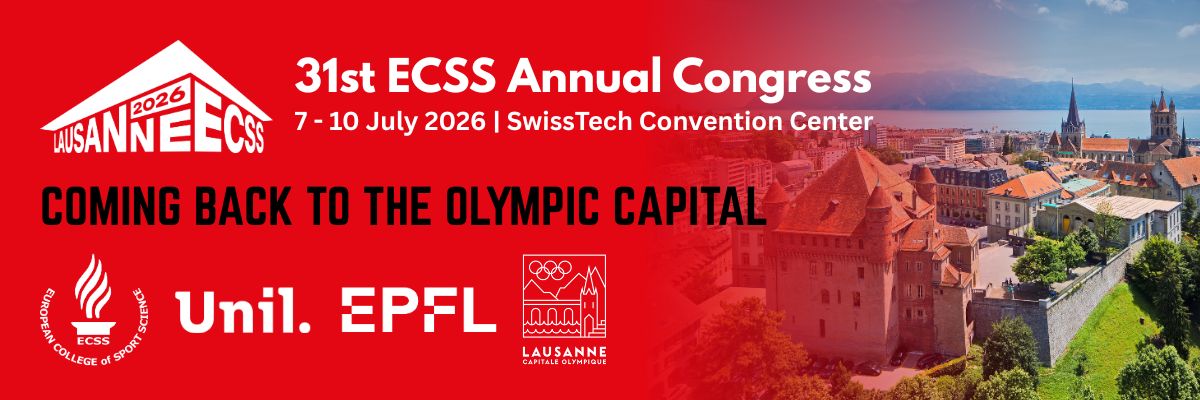Scientific Programme
Sports and Exercise Medicine and Health
IS-MH04 - Central Neuromuscular Dysfunction: Rethinking the Path to Rehabilitation
Date: 08.07.2026, Time: 08:00 - 09:15, Session Room: Auditorium B (STCC)
Description
Neuromuscular dysfunction is traditionally attributed to both central and peripheral mechanisms, with joint swelling, pain, and mechanoreceptor damage often highlighted as key contributors. However, emerging evidence suggests that central factors—particularly those governing neural drive and cortical activation—play a more dominant role in the persistence of these deficits. This shift in understanding calls for targeted interventions addressing central neural dysfunction to optimize musculoskeletal rehabilitation. In this symposium, the three presenting researchers will delve into the brain-muscle interface, exploring the neurological impact of injuries and the potential for novel treatments, such as electrical stimulation, eccentric exercise, and non-invasive brain stimulation techniques to restore function. This session will synthesize the latest advances in neuromuscular dysfunction, covering both foundational research and clinical applications, and present innovative, evidence-based therapies with the potential to significantly improve rehabilitation outcomes. While the neuromuscular dysfunction will be focused on traumatic joint injuries, insights from disuse will also be discussed. This symposium is highly applicable to scientists who study and clinicians who deal with neuromuscular dysfunction.
Chair(s)

Lindsey Lepley
University of Michigan, School of Kinesiology
United States

Speaker A
Lindsey Lepley
University of Michigan, School of Kinesiology
United States
Read CVECSS Rimini 2025: IS-MH04
Lost in Transmission: How Change in Central Motor Drive Compromises Muscle
Joint injuries such as anterior cruciate ligament (ACL) rupture cause an immediate disruption in the neural signaling required for muscle activation. This disruption leads to rapid declines in muscle volume and quality, driven by the reduced ability to generate sufficient action potentials to maintain muscle health. Emerging evidence from Dr. Lepley’s lab and others indicates that alterations in central neural drive play a pivotal role in the persistence of muscle dysfunction following traumatic joint injury. In parallel, reduced contractile activity has been linked to impaired release of synaptic extracellular vesicles—an emerging mechanism of brain–muscle communication responsible for transporting protective molecules that support neuromuscular health. In this lecture, Dr. Lepley will present translational evidence from preclinical and clinical studies describing the sequential neurological processes that culminate in complex muscle impairments after joint injury. Beginning with altered afferent input from the injured joint, she will outline how the central nervous system modulates this information and how diminished motor output contributes to muscle deterioration. Using ACL injury as a model, attendees will be encouraged to consider therapeutic strategies that promote contractile activity, enhance circulating myokine release, and stimulate muscle regeneration to optimize recovery outcomes.

Speaker B
Stephane PERREY
Univ Montpellier, EuroMov Digital Health in Motion
France
Read CVECSS Rimini 2025: IS-MH04
The Potential of Non-invasive Brain Stimulation to Address CNS Dysfunction in Sports Injury Rehabilitation
The muscle activity after joint injury often suffers from a lack of coordination and delays in initiation/termination. These deficits, which are controlled, in part, by the central nervous system (CNS), might be alleviated with an appropriate adjuvant treatment that improves CNS function. One possibly suited adjuvant treatment at the CNS level is transcranial electrical stimulation (tES), which induces cortical excitability and further neuroplasticity. TES has recently attracted attention in sports injury prevention and rehabilitation. This technique known as the most common type of non-invasive brain stimulation, uses a low-intensity electrical current (0.5–2 mA), passing through the scalp by two electrodes (anode–cathode), and can modulate the excitability of target areas in the brain. Electric stimulation works by changing the resting potential of cortical neurons. It can expedite or suppress the excitability to find out neuro-physiological function in the brain, and is being used in many different areas for recovery of performance. The primary motor cortex (M1) is the brain region that has attracted the most attention given its importance in motor function. The M1 area is involved in the development of motor programs and activation of the spinal motor neurons. Anodal tES may have positive effects on muscle strength, muscle activation and balance in the lower limbs. During his presentation Prof Perrey will discuss the underlying mechanisms of tES for rehabilitation and prevention of joint injuries. He will focus on how tES-induced effects can be optimized by identifying appropriate stimulation parameters to efficiently enhance motor function during recovery, and in turn, increase the likelihood of inducing long-lasting changes in brain networks that may outlast the stimulation period by several hours or days. As the field prepares to move non-invasive brain stimulation out of the lab and into the clinic, Prof Perrey will also carefully outline the important efficacy, safety and ethical issues the sports medicine community needs to consider when using non-invasive brain stimulation techniques as an alternative way to optimize recovery outcomes.

Speaker C
Jonathan Hughes
Cardiff Metropolitan University, Cardiff School of Sport and Health Sciences
United Kingdom
Read CVECSS Rimini 2025: IS-MH04
Boosting Neural Drive: Eccentric Exercise for Enhanced Recovery and Injury Resilience
Eccentric-biased training elicits distinct adaptations in neural drive and cortical activation, positioning it as a promising modality in rehabilitation. Compared to traditional resistance exercises, eccentric actions preferentially recruit high-threshold motor units and engage the central nervous system to a greater extent, even at submaximal loads. These properties are particularly advantageous in the context of musculoskeletal injuries, including joint injuries and muscle strains, where central neuromuscular dysfunction can hinder recovery. In injury rehabilitation, eccentric training can bridge the brain-muscle communication gap that often follows trauma. By enhancing motor unit recruitment and sustaining force output, eccentric training may mitigate the neural inhibition and synaptic disruptions that contribute to persistent weakness and instability. Additionally, the release of exercise-induced synaptic extracellular vesicles may support neuroplasticity and muscle regeneration, promoting a more robust neuromuscular system. In this presentation, Dr. Hughes will examine the mechanisms and translational applications of eccentric-biased exercise for injury rehabilitation and resilience. Emphasis will be placed on neurophysiological adaptations and their relevance to restoring central and peripheral function. Drawing on recent evidence, the session will offer practical strategies for integrating eccentric training to optimize recovery outcomes and long-term neuromuscular health.
